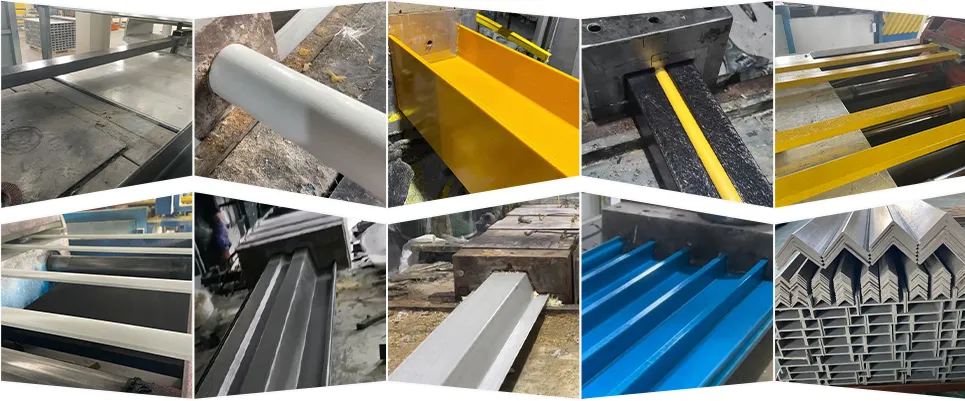loading...
- No. 9, Xingyuan South Street, Dongwaihuan Road, Zaoqiang County, Hengshui, Hebei, China
- admin@zjcomposites.com
- +86 15097380338
- Welcome to visit our website!
Exploring the Applications and Advantages of FRP Structural Components in Modern Engineering
Understanding FRP Structural Sections A New Era in Construction
In recent years, the use of Fiber Reinforced Polymer (FRP) materials in construction has gained significant traction, revolutionizing the way structural sections are designed and implemented. FRP structural sections, comprising a matrix of polymer reinforced with fibers such as glass, carbon, or aramid, offer unique advantages over traditional materials like steel and concrete. These advantages include lightweight properties, high corrosion resistance, and excellent tensile strength, making them ideal for a variety of applications.
Lightweight Properties
One of the foremost benefits of FRP structural sections is their lightweight nature. This attribute allows for easier handling and transportation during construction, reducing labor costs and time. Traditional structural materials, such as steel, can be heavy and cumbersome, often requiring heavy machinery for transportation and installation. In contrast, FRP sections can be moved and installed with less complex logistical support, promoting faster construction timelines and enhanced workplace safety.
Corrosion Resistance
High resistance to corrosion is another critical advantage of FRP materials. Unlike steel, which is prone to rusting when exposed to moisture, FRP does not corrode, which significantly extends the lifespan of structural elements. This characteristic is particularly beneficial in harsh environments, such as coastal regions or chemical plants, where traditional materials may degrade rapidly. The durability of FRP leads to lower maintenance costs over time, providing long-term financial benefits for infrastructure projects.
Design Flexibility
The inherent flexibility of FRP materials allows for innovative and aesthetically pleasing designs that may not be achievable with conventional construction materials. FRP can be molded into complex shapes and sizes, enabling architects and engineers to explore creative avenues without being constrained by the limitations of traditional materials. This design freedom can enhance the visual appeal of structures while maintaining the necessary structural integrity and performance.
frp structural sections

Strength-to-Weight Ratio
FRP structural sections exhibit an excellent strength-to-weight ratio, making them ideal for applications where minimizing weight is crucial without compromising strength. This feature is particularly advantageous in high-rise construction, bridges, and other large-scale infrastructures where reducing the load on foundation systems is essential. The ability to achieve significant spans and support heavy loads with lighter materials can lead to innovative construction techniques and reduced material usage.
Sustainable Construction
Sustainability is at the forefront of modern construction practices, and FRP materials contribute significantly to this movement. Their manufacturing process typically involves less energy consumption compared to steel and concrete production. Additionally, FRP materials can often be recycled at the end of their life cycle, further enhancing their environmentally friendly credentials. Using FRP structural sections not only aids in meeting sustainability goals but can also contribute to green building certifications, making them an attractive choice for eco-conscious developers.
Challenges and Considerations
Despite their numerous advantages, the use of FRP structural sections is not without challenges. The initial cost of FRP materials can be higher compared to traditional options, which may deter some projects. Additionally, there is a need for specialized knowledge in the design, detailing, and construction with FRP to ensure optimal performance. Training and education are vital to overcoming these challenges and unlocking the full potential of FRP in construction.
Conclusion
As the construction industry continues to evolve, the incorporation of FRP structural sections offers a promising alternative to traditional materials. With their lightweight properties, high corrosion resistance, design flexibility, superior strength-to-weight ratio, and sustainability, FRP materials are poised to play a pivotal role in the future of construction. By addressing the current challenges and promoting education and training, the construction industry can fully leverage the benefits of FRP, paving the way for more innovative and resilient infrastructures. The future of construction is undoubtedly bright with the integration of FRP structural sections.
-
GRP Structures: The Future of Lightweight, High-Performance EngineeringNewsJun.20,2025
-
FRP Water Tank: High-Performance Storage for Corrosive and Clean Water SystemsNewsJun.20,2025
-
FRP Square Tube: The New Industry Standard for Chemical and Structural ApplicationsNewsJun.20,2025
-
FRP Pultruded Profiles: The Ultimate Choice for Lightweight Structural StrengthNewsJun.20,2025
-
FRP Handrails: The Safer, Smarter, and Stronger Choice for Modern InfrastructureNewsJun.20,2025
-
FRP Grating: The Smart Solution for Durable, Lightweight Industrial FlooringNewsJun.20,2025
-
Why Choose a Galvanized Water Tank for Your Storage NeedsNewsMay.21,2025
